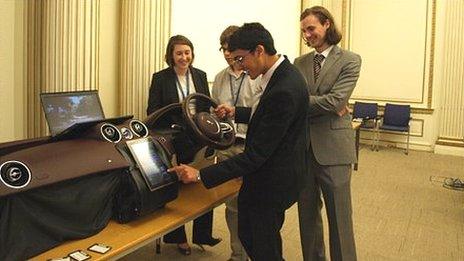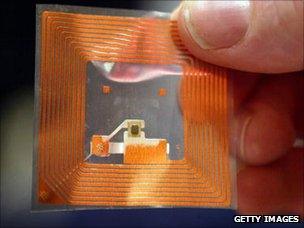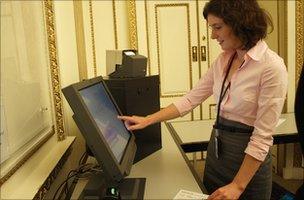Cars and cursors go smart at IBM's Extreme Blue
- Published

The Smarter Vehicle project aims to create a car that would remember someone's driving habits
Every year, IBM runs a summer internship programme for the most talented young software designers and business students.
Participants are divided into groups, each of which works on a pet project. At the end of their 12 week design period, their prototypes are presented.
The UK leg of Extreme Blue takes place at IBM's Hursley lab near Winchester. BBC News went along to see what they had dreamt up.
Smarter Vehicle
Have you ever wished that your car was a bit more thoughtful?
So that when you approach it half-asleep on a grey, chilly morning, burning coffee in your hand, it would just magically recognise you, turn itself on, maybe honk to say hello, tune in to your favourite radio station ready for the drive to work.
It might soon happen, thanks to one Extreme Blue research project - the Smarter Vehicle platform.

The Smarter Vehicle platform uses wireless RFID tags to tell the car when its driver is approaching
"As [the driver] approaches the car, it will recognise her thanks to a special RFID tag she's wearing, and will then act accordingly - adjust the seat, the temperature in the car and the radio station, for instance," said Parul Kothari from Imperial College London.
Radio Frequency Identification (RFID) tags are non-powered smart labels that can be read, without making contact, by a nearby radio receiver. Some work from as far as eight meters away.
As well as driving preferences, the system stores large amounts of information about the vehicle's use.
"Every time the driver is on a journey, the car records data about everything that has happened - from the temperature settings to where the person is going," said Mr Kothari.
Multiple sensors, both inside and outside the vehicle, continually monitor tyre pressure, door locks, GPS location and brakes.
There are even sensors on the steering wheel that check how hard it is being gripped, and others that measure the heart rate and blood pressure to keep an eye on driver stress levels.
The information is then displayed on a touch screen, internet-connected tablet attached to the dashboard.
Throughout the project, the interns have been in contact with the car maker Jaguar - a possible user of the technology if the prototype gets beyond the lab.
E-voting

To use the e-booth, voters scan their card and choose their candidate on a touch screen
One Extreme Blue UK team took on the challenge of updating the archaic process of voting. Dispensing with paper, pencils and crosses, they decided to develop an e-polling booth.
Such systems are widely used in other parts of the world, including the United States, and a range of different touch screen technologies exist.
With the Extreme Blue prototype, voters scan their polling card's barcode to generate a list of candidates, explained Emma Foley from the University of Sussex.
"You then simply have to touch the screen to select the candidate of your choice, and there's an option to go back and choose someone else in case you change your mind," she said.
Since everything is done electronically, the process speeds up the task of counting the ballots and also eliminates the paper waste - although the voters can print a copy of their ballot if they wish.
With the proliferation of touch screen devices in supermarkets, post offices and elsewhere, the team believes that people will now be comfortable enough with the concept to trust it with their votes.
"It's about time that we moved into the new realms of the 21st century and away from the archaic UK system that has been around since the 1840s," said the team's supervisor, Tim Donovan from IBM.
"I'm certain that the project will move beyond proof of concept and get adapted in the real world - if not in the UK because of all the legal hurdles of the existing system, then elsewhere."
Smart Cursor

Smart Cursor makes use of whatever motor skills the user has
Using a computer without a mouse or track pad can be tricky. Mastering those input devices when you do not have full dexterity is even harder.
One team's novel take on a control system aims to take advantage of whatever movement skills its user happens to have.
Using additional sensors, the common mouse is adapted to record additional spatial movements, beyond simply sliding around a table.
For someone who is able to use their arms quite freely, but lacks precise motor skills, the device could be strapped to one of the hands. By swinging to the left, the cursor moves left, and a rotational move indicates a click.
"The program learns the movements that people want to use, it's quite easy to train it and it can be very specific to each person," said Gemma Bailey from Oxford University.
"You can save different sets of training data, so you can easily switch between using your left hand one day and your leg another day - and this also helps with repetitive strain injury so that you're not always using the same body part."
Ms Bailey explained that the team's work was inspired by someone they worked with.
"Our mentor Melanie has multiple sclerosis and during her last attack she lost movement in her hands, but she still had full use of the movement in her arm.
"So something like this that could harness the movement and use it to control the cursor would have been really useful to her at the time."
Smarter networks
.jpg)
The software draws a picture of all of the machines in the network showing potential risks
The fourth Extreme Blue team focused on helping companies to assess the efficiency of their computer servers.
They wanted to find a way of monitoring those systems responsible for key business applications such as invoicing, payroll and purchasing, and identify which are most at risk of failure.
Because such technologies are usually hard to see, the team developed a way of visualising network processes.
"A picture would then be drawn showing all of the machines in the network and which machines talk to which other machines," said Stuart Wilkinson from IBM.
"From this, it is clear to the user which ones are most critical and potentially most at risk. If say, more than 65% of the data went through one machine, and that machine goes down, it may be a big problem."
Users are able to run simulations to show what would happen if a particular part of the system failed.
"The risk is then clear to the end user, and they can then run a second simulator showing how alternative software can be used to mitigate the risk," explained Mr Wilkinson.
Although the initial reaction to the Extreme Blue projects from different organisations had been overwhelmingly positive, IBM was unable to say if the concepts would survive beyond this year's internship.
What was clear, said Mr Wilkinson, was that the majority, if not all the interns, would be offered a job after their placement is over.
- Published14 June 2011